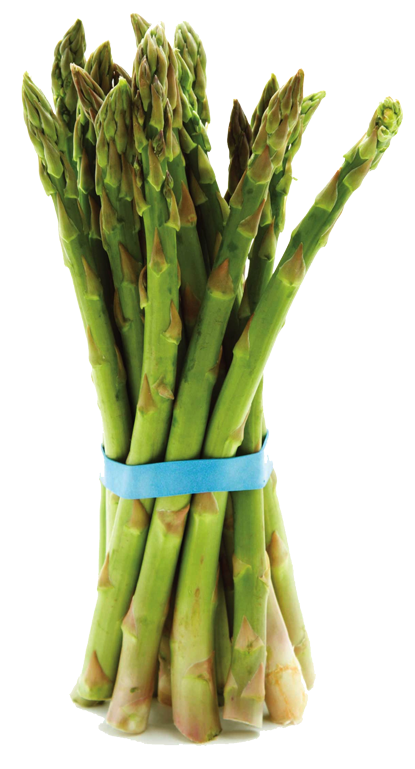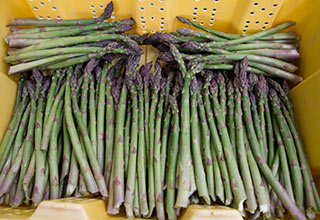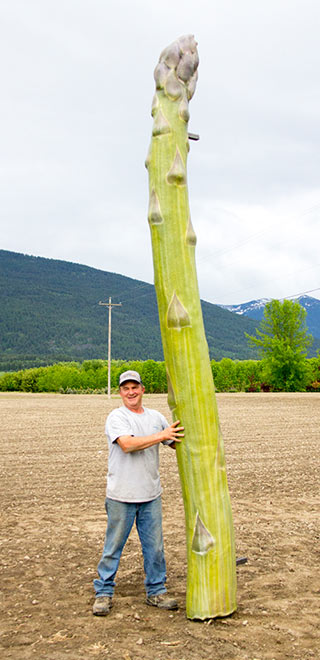





1252 Indian RD, Creston BC • 1-250-428-2734

Asparagus or Asparagus officinalis originated in Greece and is a distant cousin of the onion and member of the lily family. The word asparagus comes from the Greek language meaning ‘sprout’ or ‘shoot’. The Greeks and Romans ate it fresh when in season, and dried asparagus for use in the winter. Asparagus was considered the ‘darling’ vegetable of Roman dining tables and was a highly revered addition to feasts and festivals. A recipe for cooking asparagus is in the oldest surviving book of recipes, Apicius’s third-century AD De re coquinaria, Book III.
Asparagus became widely available in the new world around 1850. Today, China, Peru and Mexico respectively, are the major producers of asparagus worldwide. Even though consumers can now purchase and enjoy asparagus twelve months of the year, there continues to be a lot of anticipation and excitement as the first asparagus crop of the spring becomes locally available in western and eastern Canada.
Asparagus Nutritional Information
Water makes up 93% of asparagus’composition. Asparagus is low in calories and is very low in sodium. It is a good source of vitamin B6, calcium, magnesium and zinc, and a very good source of dietary fibre, protein, beta-carotene, vitamin C, vitamin E, vitamin K, thiamin, riboflavin, rutin, niacin, folic acid, iron, phosphorus, potassium, copper, manganese and selenium, as well as chromium, a trace mineral that enhances the ability of insulin to transport glucose from the bloodstream into cells. The amino acid asparagine gets its name from asparagus, as the asparagus plant is relatively rich in this compound.
Our Production & Harvest
Sutcliffe Farms grows 100 acres of Kootenay Green Asparagus on a rotational basis. Our soil type is classified as silty loam and our land is situated on a rich, fertile, alluvial flood plain. Our asparagus is sub-irrigated by the Kootenay River located adjacent to our farm. Most asparagus is grown on sand with all water and nutrients added. Our unique conditions produce a perfect asparagus spear using native minerals to create a taste like no other. We use conventional farming methods and deal with our pests in the off-season as to not jeopardize the integrity of our crops.
The planting process begins by preparing the fields. Tractors are used to dig 30 cm deep ditches, 122 cm apart. In the spring, one year old asparagus crowns are planted by hand, 20 cm apart, in the ditches Over the next two years, more soil is added to the ditches until the field is level. As asparagus plants grow, they produce a mat of roots that spreads horizontally rather than vertically. It takes four years in total for the asparagus crown to establish and strengthen itself. After the third growing season, there is an opportunity for a minimal harvest. However, the plants do not reach their full potential until the end of the fourth season. At this point they have created enough subterranean food reserves to last the season and are hearty enough to harvest. Asparagus is a hardy perennial and with care, asparagus plants can produce for over fifteen years.
Traditionally, our picking season begins around the first of May and continues for six weeks. However, an early spring, with warm ground and overnight temperatures can result in an earlier start date. Conversely, a cold spring makes for a later start date. Towards the end of the season, the plants will let us know they are getting tired. The daily yields decrease and the asparagus crowns must work harder to produce the same diameter spear. Once that happens, the fields are shut down and the plants go to fern. The asparagus fern reaches a height of six to seven feet and is left over the summer to replenish its subterranean food reserves for the following season. After the first hard frost, the vibrant, green fern changes to a brackish brown. The fern is then mulched and tilled back into the ground providing more organic nutrients to the plants. In the spring, any remaining organic matter is then worked again back into the soil. As the spring brings warmer temperatures, the soil warms up and asparagus spears shoot to the surface again. We are then ready to harvest for another season.
There is little need for scarecrows on our farm as asparagus is not liked by most wild animals. Asparagus seeds are mainly transported by birds and are indigestible to them. The undigested asparagus seed is excreted by the birds and is responsible for the propagation of wild asparagus. Our product is distributed throughout western Canada through our farm gate, fruit stands, restaurants and grocery outlets. We have both retail and wholesale pricing. Please contact Sutcliffe Farms for a more comprehensive price list.

Asparagus
Nutritional Information
Nutritional value per 100 g (3.5 oz)
Energy
Carbohydrates
Sugars
Dietary fibre
Fat
Protein
Vitamins
Vitamin A equiv.
beta-carotene
lutein zeaxanthin
Thiamine (B1)
Riboflavin (B2)
Niacin (B3)
Pantothenic acid (B5)
Vitamin B6
Folate (B9)
Choline
Vitamin C
Vitamin E
Vitamin K
Trace metals
Calcium
Iron
Magnesium
Manganese
Phosphorus
Potassium
Sodium
Zinc
85 kJ (20 kcal)
3.88 g
1.88 g
2.1 g
0.12 g
2.2 g
(5%) 38 μg
(4%) 449 μg
710 μg
(12%) 0.143 mg
(12%) 0.141mg
(7%) 0.978 mg
(5%) 0.274 mg
(7%) 0.091 mg
(13%) 52 μg
(3%) 16 mg
(7%) 5.6 mg
(7%) 1.1 mg
(40%) 41.6 μg
(2%) 24 mg
(16%) 2.14 mg
(4%) 14 mg
(8%) 0.158 mg
(7%) 52 mg
(4%) 202 mg
(0%) 2 mg
(6%) 0.54 mg
























